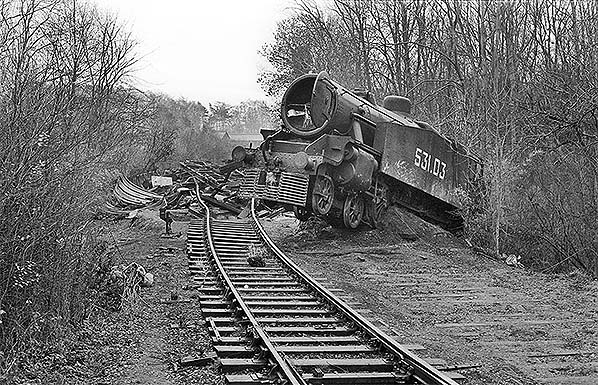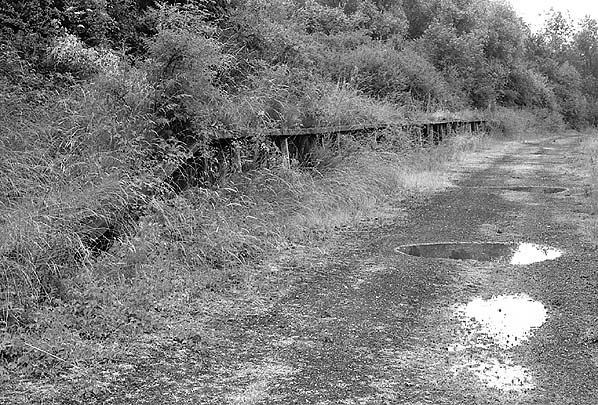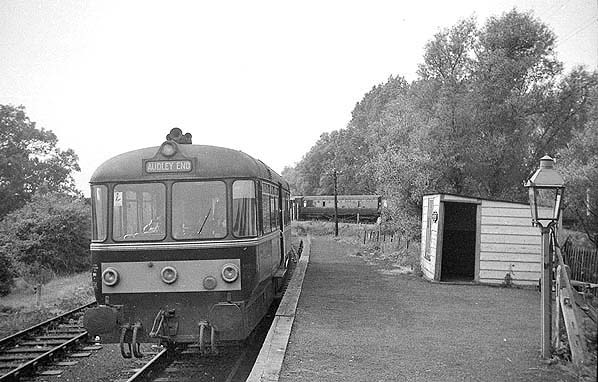
Bartlow (Saffron Walden branch platform) Gallery 2:
old6.jpg) The Bartlow branch platform appears to be the centre of attention on this occasion. There are some eager-looking passengers on the railbus and at least two people, including the photographer, taking photographs while the signalman watches from the top of the signal box steps. The railbus is E79961 which, notwithstanding its number being just visible, is identifiable by its large yellow warning panel and overhead warning flash near the top of the curved light. The position of the overhead warning flash tells us that the photograph was taken not long before the branch closed. It is possibly the penultimate day as E79961 is known to have been working the branch that day and it was photographed elsewhere on the branch on the same day until replaced in the evening by E79963. This image provides an opportunity to mention the branch platform at Bartlow, which had subsided back away from the track. The remedy had been to extend the platform edge with timber and to support it with the apparently white posts seen on the right. Only a sufficient length of platform had been so treated, enough for a push-and-pull train or, later, a DMU, and the start of the untreated section, which was effectively abandoned, can just be seen on the far right.
Photo from Jim Lake collection old7.jpg) This photograph was possibly taken at the same time as the other view of E79961 at Bartlow. It is certainly during the same period. The post on the left bearing a totem is a little odd. It originally supported a lamp identical to that seen adjacent to the entrance but has had an extension with a hook added. This would have been to hang a lantern or Tilley lamp from although no evidence of either has been seen. In any event, once the little railbuses had taken over the service all that would have been required was the lamp beside the entrance. At Bartlow – and, indeed, Ashdon, where passengers waited in the old carriage body - it must have been a strange experience, especially after dark, to wait on an isolated oil-lit cinder platform and then enter the bright, modern, interior of a diesel railbus or, on occasion, a DMU. The waiting shelter appears to have been well maintained until the end. The railbus has its tail lamp in place ready to trundle back to Audley End but the rear destination blind has not been changed. This, as mentioned elsewhere, was common practice. As with rear blinds on road buses, it has often been said that if anyone can see what is displayed on the rear then they have probably missed it anyway.
Photo from Jim Lake collection old8.jpg) In the summer of 1968 a demolition train leaves the Saffron Walden branch at Bartlow Junction. The locomotive is a Brush Type 2 (Class 30/31). These trains took reusable track materials to Chesterton Junction, Cambridge, and it was the practice to leave any wagons which had not been loaded at Linton; these wagons were then collected when the train returned the next day and taken to the Saffron Walden branch, the procedure then being repeated as necessary. The reason for this was that gradients, in particular Ashdon Bank, forbade the leaving of wagons with no locomotive in attendance on the branch overnight and at weekends. By the time that the above photograph was taken, the Stour Valley line was also disused, having closed in March 1967. Demolition trains running over disused lines were restricted to a maximum speed of 15mph; the train seen above would therefore take quite some time to reach Shelford Junction. The junction at Audley End was removed soon after the branch closed so all demolition trains operated via Bartlow. The track through the branch platform, including the loop, and a few hundred yards along the branch remained in situ until 1970 to allow filming of ‘The Virgin Soldiers’. The train used in this part of the film was positioned off the rails by Cambridge breakdown crane (not deliberately run off a damaged section of track as popular myth claims) and although preparations required use of both tracks through the branch platform, once the train was in position the rails seen above had their heads painted silver to resemble a railway still in use. Given that Bartlow station was not seen in the film, this little piece at artwork was completely pointless. Images of the 'wrecked' train exist but for copyright reasons it has unfortunately not been possible to include them here. If any private individual who happened to penetrate the site with a camera can help in this respect
we would be most grateful. Photo from Jim Lake collection  The scene along the Saffron Walden branch just outside Bartlow on 7 December 1968, a few weeks after completion of filming for The Virgin Soldiers. The coaching stock is in the process of being scrapped while Federated Malay States Railways L class No.531.03 awaits the same fate following an abortive preservation attempt. The locomotive is, of course, Stanier Black Five No.44781. For more information see The Virgin Soldiers feature.
Photo by Tim Stephens 16.jpg) With Linton and Cambridge behind the camera, Haverhill to the left and Audley End to the right, this is Bartlow Junction on a rainy day in October 1974. The track, on both sides of the station, had been lifted just four years previously. The contrast between the proper station, left, and Saffron Walden branch platform, right, is well illustrated. The signal box remained in the condition seen above for a further 36 years until, by then largely hidden in woods, it collapsed in 2010. It had been intended to provide a turntable at Bartlow for, presumably, Saffron Walden branch locomotives. In February 1867 the GER Way & Works Committee mentioned the turntable as well as inadequate ballasting on the branch and constant problems with landslips and subsidence. The matters were passed to the Saffron Walden Railway Company and, perhaps unsurprisingly, the turntable was never heard of again. The subsidence problems were to remain with the branch for its entire life. One can only guess at where a turntable at Bartlow might have been located.
Photo
by David Burrows from his Flickr photostream
19.jpg) The Bartlow branch platform in 1974 looking towards Saffron Walden. As in other images, the repaired and non-repaired sections of platform are obvious. By this time, and from this angle, it was becoming difficult to discern where the access path was: it was where the area of less dense bushes is, to the right of the centre of the image.
Photo by David Burrows from his Flickr photos 17.jpg) Looking along the trackbed towards the junction in October 1974. The Saffron Walden branch platform was 210ft (the same as Ashdon) and after 1951, when push-and-pull trains were introduced, only a portion of the platform was ever used regularly. The slightly lower section of platform nearest the camera was effectively abandoned following counter-subsidence repairs which resulted in the raised
section in the distance. Photo by David Burrows from his Flickr photostream 18.jpg) Looking along the platform towards the junction in October 1974.
Photo by David Burrows from his Flickr photostream 15.jpg) Looking along the platform towards the junction in October 1974, this time from adjacent to the access pathway from the main part of the station. No trace remains of the waiting shelter, which stood directly ahead of the camera and just beyond the wooden fencing seen right of centre. This was the fencing which once bore the oddly-worded sign directing passengers to the main station. The post in the right foreground once supported the oil lamp visible in so many images. One wonders who removed the waiting shelter and why. The shelter was still present when the line closed but had gone by the time the track was lifted, at Bartlow, in 1970. BR would have had little or no use for the wooden structure by that time. Perhaps it was chopped up for firewood.
Photo by David Burrows from his Flickr photostream 22.jpg) An October 1974 view along the path between branch platform and main station, the latter being largely obscured by the tall tree in the background. On the right is the post from which an oil lamp once cast a few lumens over the platform and to its left the relatively modern concrete fence post can be seen. To the left, part of the fencing which once bore the 'Cross the Road' sign can just be made out. The section of this fence remaining in 1974 is off the picture to the left. The fencing alongside the path with thin stanchions was of railway origin. It was widely used on and around the branch platform, can be seen in numerous images and could even have been installed when the line was built. No pictures of Bartlow branch platform are clear enough to judge, but these stanchions often resembled rails as used on small-gauge railways; whether they once were is not known. Some of this fencing has been used to crudely block off the access path. This may have been done to mark a property boundary after BR sold the main station or it may have been done in 1968 when ‘The Virgin Soldiers’ was filmed. During the period of filming the area was cordoned off, including from alongside the Ashdon Road, albeit not very effectively, and the curious had no trouble reaching the site once filming was complete and before the train was scrapped. Photo by David Burrows from his Flickr photostream  Bartlow branch platform looking towards Ashdon in June 1975. Almost eleven years after closure, but just five years after the track was lifted at this location, nature is rapidly taking over. From this viewpoint it is impossible to determine where the entrance was; it was where the lighter clump of undergrowth can be seen about two-thirds of the way along the visible length of platform. Beyond where the platform disappears completely into the undergrowth in the distance is the section which became disused following makeshift counter-subsidence repairs. Despite the invasion of undergrowth on the platform, the trackbed remains largely clear. This scenario was quite common at abandoned stations due to decades of oil and ash deposits which, over time, penetrated into the ground.
Photo by Nick Catford 14.jpg) In July 1978 the scene at Bartlow is reminiscent of a pleasant walk along a forest track and, to all intents and purposes, that is precisely what it is. Part of the platform remains visible on the right but it is rapidly becoming engulfed. In the background, Bartlow Junction signal box stands as a ghostly reminder of the past. This view is 14 years after the Saffron Walden branch closed, 11 years after the Stour Valley line closed and a mere eight years after the track was finally removed. It should be remembered that track-lifting on the Saffron Walden branch took place in 1968 apart from 500-or-so yards at the Bartlow end, which was lifted with the Stour Valley line in 1970.
Photo by Martin Willetts 21.jpg) An August 2011 view from the trackbed of the Saffron Walden branch, looking towards Bartlow station building in the background. In the foreground a short length of the branch platform can be seen. What we are looking at appears to be the extant extended platform face as right of centre one of the supports which were added as part of this work. The support has partially collapsed and is leaning towards the left. The camera is directly facing what was once the platform entrance and along what was once the footpath leading to and from the main part of the station. The waiting shelter stood to the left, the actual site being off the image, and where the tree is to the right once stood an oil lamp. The fence which once bore a sign directing passengers to 'Cross the Road' would have stood behind the heavy undergrowth on the left. The land between branch platform and main part of the station has been grassed and there is no obvious trace of any of the features connected with the branch platform and the footpath.
Photo
from John Sutton, reproduced from Geograph under creative commons licence
20.jpg) Bartlow branch platform in April 2015. The view is towards the junction. The trackbed was on the left and the platform curves to the left in the distance, although the latter is not readily apparent in this view. The photographer informs us he was standing at the Saffron Walden end of the platform so, taking this literally, the section of platform edge visible above is the original. As described elsewhere, the branch platform subsided away from the track and part of the platform received an extended edge supported by wooden props. About one third of the platform, at the Saffron Walden end, was not so treated and thus became disused. This will be the section of platform seen above. When this work was undertaken is not clear but photographic evidence tells us that it was around the time that push-and-pull working was introduced in 1951. This makes sense as the push-and-pull trains were fixed two-coach formations, with the original driving trailers being narrow-bodied, and they would not have required the full length of the platform. The item of ironmongery lying on the platform cannot be identified. It may be the post which supported an oil lamp at this end of the platform but its cross-section appears to be rather too thin for that. The birch trees appear to be recent arrivals at Bartlow as none are apparent in other post-closure views.
Photo from Kitmasterbloke Flickr Photostream
 Home
Page Home
Page
|


